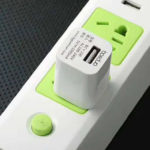Why do birds sit on high voltage power lines without getting electrocuted?
It’s not because birds have extraordinary abilities to avoid getting electrocuted when perched on power lines.
First, we need to understand that electrical current is the movement of electrons through a conductor. Electrons always seek the path of least resistance, which means the path with the least electrical impedance to flow through.
Normally, power transmission lines are made of copper. Copper is a low-resistance metal and has good conductivity. In contrast, a bird’s body has high electrical resistance and is a much poorer conductor than copper. Therefore, the electrical current will bypass the bird’s body and flow through the power line.
In addition, if you pay close attention, you will notice that small bird species often perch on power lines with both feet touching the same line. Electric current flows from the high to the low potential. Different power lines usually have different potentials. Since the bird’s two feet are in contact with the same line, they have the same electrical potential, do not form an electrical circuit, and the bird does not get electrocuted.

However, if a bird places its feet on two different power lines (lines with different potentials) or its feet touch one line while another part of its body touches another line, the electric current will flow from the high potential to the low potential and electrocute the bird.
Larger birds such as hawks, eagles, and owls are more susceptible to electrocution when perched on power lines because they have large size and their two feet could be on one line while their wings may touch another line, forming a closed electrical circuit.
In the United States, between 1978 and 1998, over 2,000 birds of prey were recorded dead in Nebraska, Kansas, Colorado, Wyoming, and Dakota, half of which were electrocuted, and 75% of the electrocuted birds were eagles.
For humans, under constant voltage conditions, the current flow through the body depends on the body’s electrical resistance. The higher the contact voltage, the greater the current flowing through the body. Larger electrical resistance results in smaller current, and vice versa, smaller resistance results in larger current.
How do power workers ensure safety while working with live power lines?
The electrical resistance can range from about 10,000 to 100,000 ohms for a normal person in dry conditions. Since the human body’s resistance mainly concentrates on the skin, the safe voltage for humans varies with the condition of the skin. If the skin is dry and clean, then a voltage below 40V is considered safe. On the other hand, if the skin is wet and damaged, the safe voltage is 12V.
However, it should be noted that even if the body is dry, when touching a 220V voltage, a person can still get shocked, although it may not have serious effects. If the hands are wet or a part of the body touches water, the 220V voltage will cause a shock and pose a threat to life (since water is a good conductor that significantly reduces the resistance on the skin, resulting in a higher current).
Power workers who work on live power lines – meaning the power is not shut off – must be equipped with insulating materials including clothing, gloves, helmets, and shoes. Furthermore, when working, they must follow safety rules, which include only touching one wire at a time, absolutely not touching two wires at the same time.
Explore 12 Amazing Destinations for Biking Trips
Unlock Vietnam in a brand new way with an exciting biking tour! Discover the stunning beauty of the country with Dien May XANH’s top 12 must-see destinations. From sweeping plains to clear blue beaches and mountainous vistas – experience all the sights with your own personal cycling tour. Find your ideal route and set out for an adventure today!



































